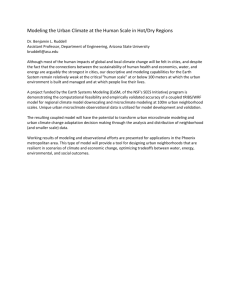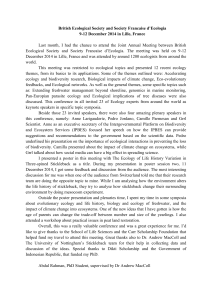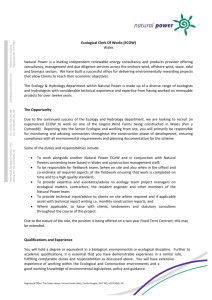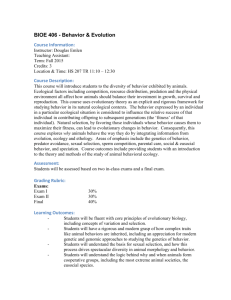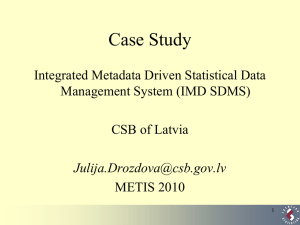GCB Letter to Editor
advertisement
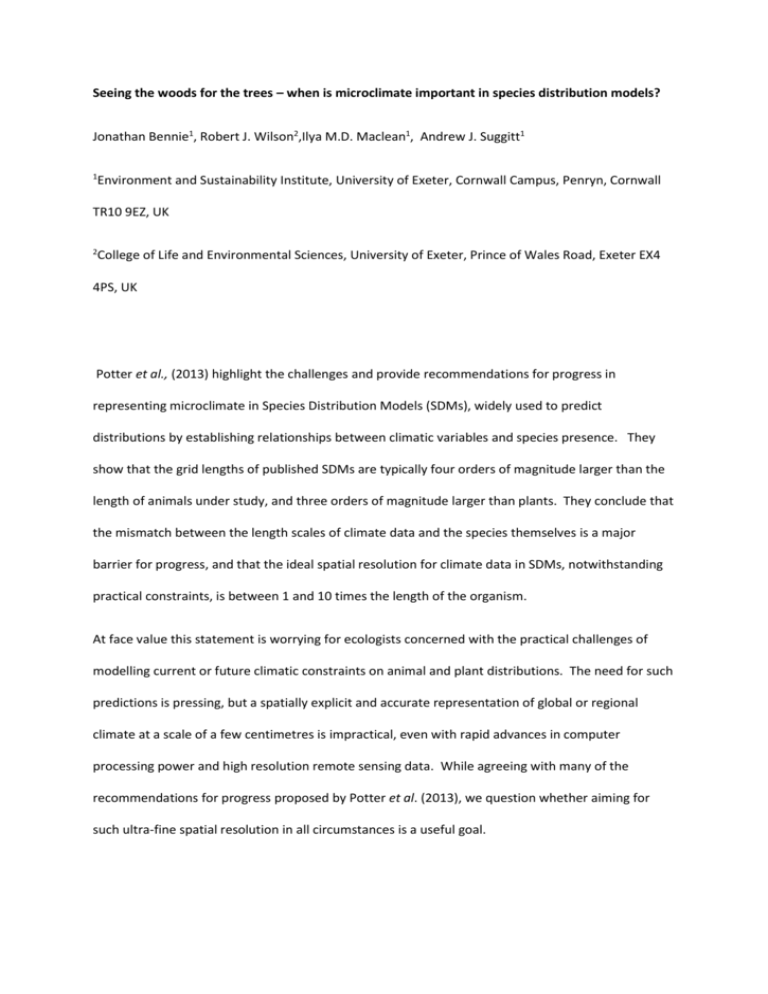
Seeing the woods for the trees – when is microclimate important in species distribution models? Jonathan Bennie1, Robert J. Wilson2,Ilya M.D. Maclean1, Andrew J. Suggitt1 1 Environment and Sustainability Institute, University of Exeter, Cornwall Campus, Penryn, Cornwall TR10 9EZ, UK 2 College of Life and Environmental Sciences, University of Exeter, Prince of Wales Road, Exeter EX4 4PS, UK Potter et al., (2013) highlight the challenges and provide recommendations for progress in representing microclimate in Species Distribution Models (SDMs), widely used to predict distributions by establishing relationships between climatic variables and species presence. They show that the grid lengths of published SDMs are typically four orders of magnitude larger than the length of animals under study, and three orders of magnitude larger than plants. They conclude that the mismatch between the length scales of climate data and the species themselves is a major barrier for progress, and that the ideal spatial resolution for climate data in SDMs, notwithstanding practical constraints, is between 1 and 10 times the length of the organism. At face value this statement is worrying for ecologists concerned with the practical challenges of modelling current or future climatic constraints on animal and plant distributions. The need for such predictions is pressing, but a spatially explicit and accurate representation of global or regional climate at a scale of a few centimetres is impractical, even with rapid advances in computer processing power and high resolution remote sensing data. While agreeing with many of the recommendations for progress proposed by Potter et al. (2013), we question whether aiming for such ultra-fine spatial resolution in all circumstances is a useful goal. The apparent mismatch between the scale of climate data and the size of organisms is bridged implicitly in most SDMs with a “mean field approximation”, by assuming that grid-cell average climatic variables are statistically meaningful predictors of the probability of species persistence. This assumption does not necessarily require that the gridded climate data accurately represent the microclimate experienced by any individual within that grid cell, or as Potter et al. (2013) suggest, that all species within a grid cell experience the same climate. The mean field approach simply requires that macroclimate is a good predictor of the aggregated population-level effect of many individual responses to the spatial and temporal variation in microclimate that influence individual performance. Often this is a reasonable assumption; while it is true that “current climate data are coarse because it is difficult and expensive to sample simultaneously at fine scales and geographical extents” (Potter et al., 2013), gridded climate data only exist at all because they are useful. Statistical correlations between large-scale climate and a range of physical and biological phenomena (not limited to species distributions) are well established, and frequently robust without downscaling to the scale of the mechanistic processes involved. When studying thermal physiology, clearly it is desirable to take temperature measurements as close as possible to the organism (or organ) of interest. However, the aim of a SDM is not to predict physiological rates of an individual, but the presence or absence of populations, where the response variable is usually mapped at a similar resolution to the climate data itself. Linking SDMs to physiological mechanisms is clearly appealing in terms of understanding the mechanisms underlying species responses (Kearney and Porter 2004, Crozier and Dwyer 2006, Buckley et al, 2010), but downscaling coarse resolution climate data to an appropriate spatial and temporal scale (Kearney et al., 2012) is only half of the challenge. Physiological rates must also be scaled, either explicitly or implicitly, up to higher levels of ecological organisation - to individual fitness, survival and reproductive rates, population dynamics (Buckley et al., 2008) and possibly metapopulation dynamics (Bennie et al., 2013) before they finally translate into distribution maps at the desired ecological scale (Figure 1). Such ecological models may themselves be sensitive to mean field approximations (Morozov and Poggiale 2006) – for example scaling from individuals to populations or local populations to metapopulations. In practice, greater accuracy in describing the operative temperature of organisms (Bakken 1992) will only improve SDM predictions if coupled with accurate ecological models to scale from physiology to distribution. To decide when to downscale climate data, we must first establish why we are doing it – the fact that coarse-scale climate data does not accurately represent the climate as experienced by an organism may not in itself be a sufficient reason. Representing microclimate in SDMs is likely to be desirable in at least three types of circumstance - when predictions of distribution are needed at a high resolution; when mechanistic insights into the physiology driving species responses to climate are required; and when the mean field approximation of classic SDMs is unsatisfactory and nonlinear responses to microclimate availability become critical in determining the distribution of species at a large scale. We advocate a focus on identifying the conditions under which mean field approximations break down, and the spatial scales at which this breakdown occurs, in different systems, tested where possible against field observations. In this way we may strengthen general recommendations for the appropriate scales at which best to model the responses of species distributions to climate change. References Ashcroft MB, Chisholm LA, French KO (2008) The effect of exposure on landscape scale soil surface temperatures and species distribution models. Landscape Ecology 23 (2), 211-225 Bakken GS (1992) Measurement and application of operative and standard operative temperatures in ecology. American Zoologist, 32, 194–216. Bennie, J., Hodgson, J.A., Lawson, C.R., Holloway, C.T.R., Roy, D.B., Brereton, T., Thomas, C.D., Wilson, R.J. (2013). Range expansion through fragmented landscapes under a variable climate. Ecology Letters, 16(7), 921-929. Buckley, LB (2008) Linking traits to energetics and population dynamics to predict lizard ranges in changing environments. American Naturalist, 171, E1–E19. Buckley LB, Urban MC, Angilletta MJ, Crozier LG, Rissler LJ, & Sears MW (2010). Can mechanism inform species' distribution models? Ecology Letters 13: 1041–1054 Crozier L, and Dwyer G (2006) Combining population-dynamic and ecophysiological models to predict climate-induced insect range shifts. American Naturalist 167:853–866. Kearney, M. & Porter, W.P. (2004). Mapping the fundamental niche: physiology, climate, and the distribution of a nocturnal lizard. Ecology, 85, 3119–3131. Kearney MR, Matzelle A, Helmuth B (2012) Biomechanics meets the ecological niche: the importance of temporal data resolution. Journal of Experimental Biology, 215, 922–933 Morozov A and Poggiale J-C (2012) From spatially explicit models to mean-field dynamics: The state of the art and perspectives. Ecological Complexity 10, 1-11 Potter KA., Woods HA., and Pincebourde S. (2013) Microclimatic challenges in global change biology. Global Change Biology 19:10 2932-2939 Figure 1: Climatic and ecological scaling in species distribution models (SDMs). The aim of an SDM is to predict a species’ distribution from a set of environmental (including climatic) variables. Most SDMs apply a statistical relationship directly between climate and distribution at a coarse scale. Alternative approaches taken by selected key studies is shown by arrows; solid arrows show explicit representation of processes between scales (for example multiple microclimates modelled within a climate grid square, multiple populations modelled within a metapopulation), dashed lines represent mean field approximations (for example fitness of an individual scaled to population dynamics).
